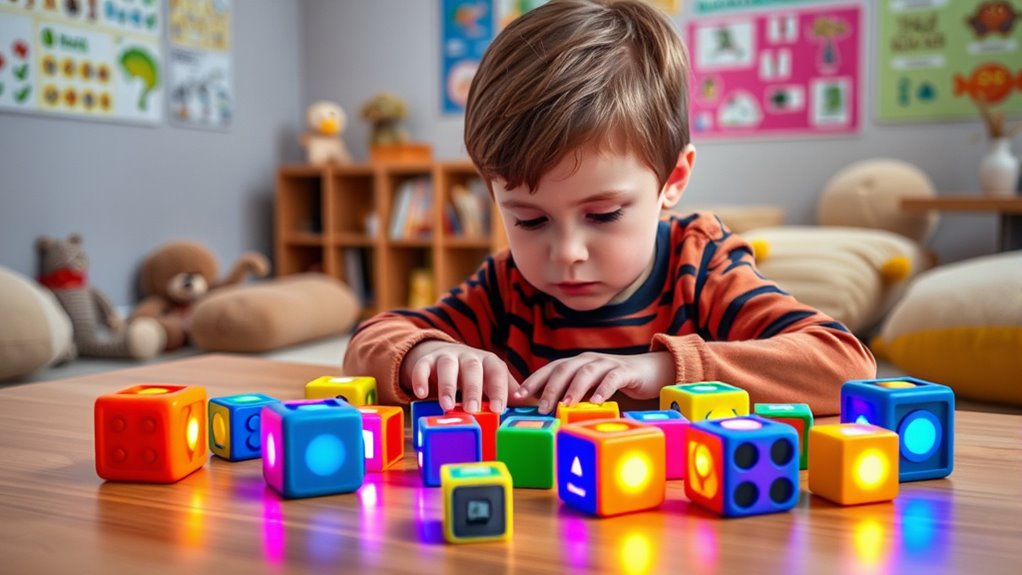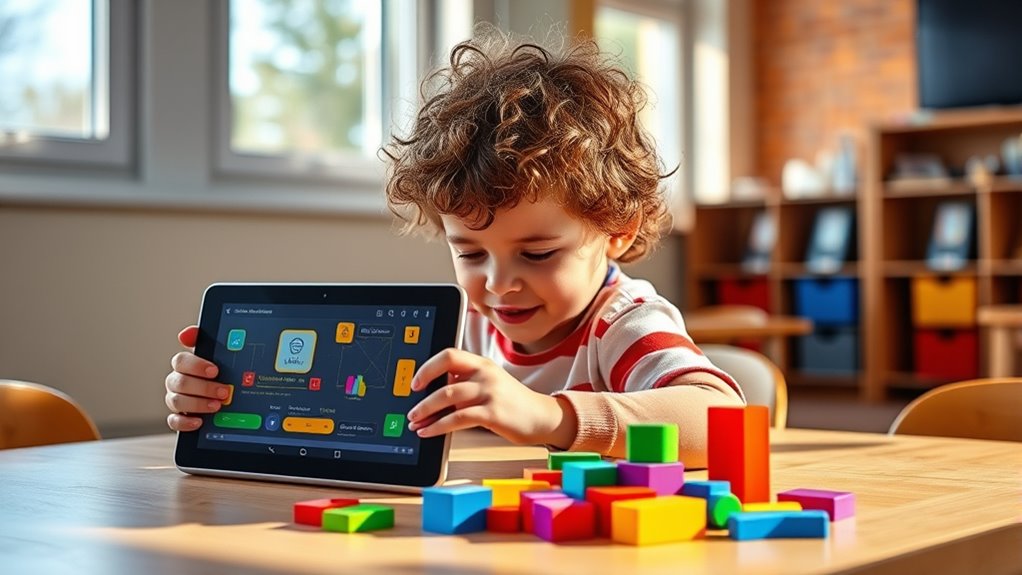Starting with beginner coding toys and games for kids makes learning to code easy and fun. You’ll find colorful interfaces, animated characters, and game-like challenges that turn programming into an engaging adventure. Robots are great tools for teaching movement and problem-solving, with simple drag-and-drop languages that give instant feedback. As you explore more, you’ll discover how these tools build your child’s logical thinking while setting the stage for future tech skills. Keep going to learn even more ways to inspire young coders.
Key Takeaways
- Beginner coding toys use visual, drag-and-drop interfaces to simplify programming for kids.
- Robots and virtual environments make coding interactive and engaging for young learners.
- Challenges and milestones promote critical thinking and build confidence through achievable goals.
- Bright, gamified designs and animated characters boost curiosity and enjoyment in learning to code.
- Early exposure through these toys develops foundational skills for future programming education.

Have you ever wondered how kids can start learning to code at a young age? The good news is that there are many beginner coding toys and games designed specifically for children. These tools make coding accessible and fun, helping kids develop essential problem-solving skills early on. One popular way to introduce children to coding is through robot programming. Kids love robots, and when they get to program a robot to turn, move, or perform tasks, it turns learning into an exciting adventure. Many beginner robot kits come with simple, visual programming languages that let kids drag and drop commands, making it easy to understand the logic behind coding without needing to write complex syntax. As they experiment with robot programming, children get immediate feedback—watching their robots execute commands reinforces their learning and keeps them engaged. Additionally, child-friendly interfaces play a crucial role in making coding less intimidating and more approachable for young learners.
Coding challenges are also a core element of these toys and games. They offer a playful way for kids to apply what they’ve learned, encouraging them to solve puzzles or complete tasks using code. For example, a coding challenge might require a child to program a robot to navigate a maze or pick up objects in a specific order. These challenges build critical thinking and sequencing skills, all while keeping the activity fun. Many educational toys incorporate levels or milestones, so children can start with simple tasks and gradually take on more complex problems as their confidence grows. This incremental approach prevents frustration and promotes a sense of achievement.
Most beginner coding toys focus on making learning intuitive. They often feature colorful interfaces, animated characters, and gamified elements that appeal to kids’ natural curiosity. For instance, some programming games simulate a virtual world where kids can code characters to perform actions, making the experience interactive and engaging. These toys often come with step-by-step tutorials that guide children through different coding concepts, helping them understand how to break down a problem and think logically. By tackling coding challenges through play, kids develop foundational skills that prepare them for more advanced programming in the future.
Frequently Asked Questions
What Age Is Best for Starting Beginner Coding Toys?
You might wonder what age is best for starting beginner coding toys. Generally, toys designed for ages 5 to 8 are ideal, as they offer age-appropriate challenges and foster developmental benefits like problem-solving and logical thinking. At this stage, kids develop important skills while having fun. Introducing coding toys early helps build a strong foundation, making future learning easier and more engaging as their cognitive abilities grow.
Are Coding Toys Suitable for Children With No Tech Experience?
In the grand scheme of things, coding toys are perfect for children with no tech experience. You should know that these toys introduce basic programming languages in a fun, engaging way. With your parental involvement, your child can grasp concepts quickly and build confidence. These tools are designed to be intuitive, making learning to code accessible, even if they’re just starting out, turning tech novices into future programmers.
How Do I Choose the Right Coding Game for My Child?
When choosing the right coding game for your child, consider their age and interests. Look for games with engaging, interactive tutorials that make learning fun and easy to follow. Guarantee the game offers parental controls so you can monitor progress and set limits. By selecting a game tailored to your child’s skill level and preferences, you help foster their curiosity and confidence in coding while keeping their online experience safe.
Can Kids Learn Advanced Coding Skills With Beginner Toys?
You might wonder if beginner toys can open advanced coding skills. The answer depends on the toy’s features; some introduce robot programming and expose kids to coding language options that grow with their abilities. While they may start simple, these toys can challenge your child to learn more complex concepts over time. With the right tools, your kid can definitely progress from basic to advanced coding skills, fueling their curiosity and future success.
What Safety Features Should I Look for in Coding Toys?
When choosing coding toys, you should look for safety features like battery safety, ensuring the toy has secure compartments and low voltage. Also, check that the materials are non-toxic, so your child isn’t exposed to harmful chemicals. These features help keep your kid safe during play. Always read reviews and manufacturer info to confirm the toy meets safety standards, giving you peace of mind while they learn and have fun.
Conclusion
Just like a young explorer sets sail with a sturdy map, these beginner coding toys and games empower you to chart your child’s digital journey. With patience and curiosity, they’ll discover a world of endless possibilities, turning simple commands into remarkable creations. Remember, every great coder starts with small steps—think of this as planting seeds for a future where innovation blossoms. Embrace the adventure, and watch your child’s confidence and skills grow beyond what they imagined.











